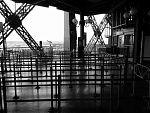25. Dezember 2014
Train to Paris
 It was my second time in France. After exploring the countryside in the Auvergne a decade ago, this time I visited the capital over a weekend while travelling from London to Munich by train and by bus. A mixed story about discovering Paris by foot.
It was my second time in France. After exploring the countryside in the Auvergne a decade ago, this time I visited the capital over a weekend while travelling from London to Munich by train and by bus. A mixed story about discovering Paris by foot.
Usually, I tend to be interested more in the wild nature and landscape than in cities. After all, cities is where I use to live in all the time, whereas the wild parts is left for me to discover during vacation. Anyway, this Christmas I decided to travel from the UK via France to Germany by train, and did not want to miss the chance to stopover in Paris.
The first thing I want to do in a city is to get an overview of the layout. This tells me what is located where, lets me estimate distances, and subsequently makes looking at maps mostly redundant. Not needing a map is beneficial if you don’t happen to have a map, and mobile data is either slow or happens to be prohibitively expensive. Not having planned in advance, I therefore decided to head over to and up the maybe most obvious thing in Paris: the Eiffel Tower. It was quite a walk from Gare du Nord, where I arrived, and at first, the tower was not visible which made navigation a little bit more cumbersome.
The Eiffel Tower is an amazing piece of engineering. An enormous structure, built over a century ago, made of steel, with the wind able to blow right through. I found it particularly great that you can walk up to the second level. However, it is a pity that it is no longer possible to climb the stairs up to the top. In any case, the panorama from the top is excellent, and no other buildings obstruct the view over Paris. One can see the triangle mesh of the streets of Paris, which is in stark contrast to a Manhattan-like grid.

Well, the view from the Eiffel tower is unobstructed with one exception – the incarnation of ugliness that is la Tour Montparnasse. Yes, it is a very ugly skyscraper and I am not the first one to mention it. The problem is just that with all its ugliness, it sticks out of as the only skyscraper among all the other much prettier low-rise buildings. According to Wikipedia, some people argue that you get the most beautiful view of Paris from la Tour Montparnasse – because it is the only place where you cannot see the tower itself. While I did not go up, I think this statement is spot on, and it also seems that the advertisers of the viewing platform are aware of it:

Talking about architecture and non-architecture, I also passed the Centre Georges Pompidou on the northern side of the river Seine, which is built in the same architectural style (Bowellism) as the Lloyd’s building in London.

Once in a while, I discover the photographer in me, and equipped with my absolutely professional photographing equipment (a mobile phone), I take a few pictures of places where thousands of other people already have taken a picture before. So what is the point? A while ago, I stumbled over pretty impressive pictures on popular and crowded spots in London, being completely empty on special occasions (Empty London). So experimented a little bit on a rainy Friday in Paris and took a few pictures of the Louvre without people (well there was a queue, but you cannot see it on the picture), and an empty spot on the Eiffel Tower (there was no queue, but apparently there are humongous queues in summer).

The Louvre – empty.

Jardin des Tuileries – empty.

Jardin des Tuileries – still empty.

The Eiffel Tower – empty.
[…]
I chose to stay at Montmartre. This is very practical due to the proximity to Gare du Nord (where I arrived) and Gare de l’Est (where I departed). From the place I stayed, I could walk up the stairs to the Sacre Coeur on top of Montmartre. This short five minute trip allowed me to see Paris in the morning, and Paris at night. The ownly downside was that the the Eiffel tower cannot be seen from most angles in contrast to the ugly face of Tour Montparnasse.

While in Paris, I looked a little bit in the art of engineering. I learnt that the Eurostar connecting London with Paris and Brussels is actually a TGV, modified for use in the Eurotunnel and the UK.

Furthermore, I found out about the sucess story of the TGV by browsing the extensive material on Wikipedia. I did not know there was a Duplex TGV until I booked a ticket. I did not know the random fact that one of the loops for the Eurotunnel Shuttle goes clockwise and the other goes counter-clockwise in order to balance the wear on the wheels of the train – I am really curious who thought about this detail when planning the construction.

And finally, I did not know that there had been efforts to develop hovercraft trains in history. At least in France and in the UK, there had been efforts to develop a high-speed train on an aircushion. Obviously, these hovercraft trains never came into operation. Nevertheless, now I have another quest back in the UK: going to Peterborough in order to visit the last remainders of a hovercraft train, one of the uncountable inventions in human history that never made it.